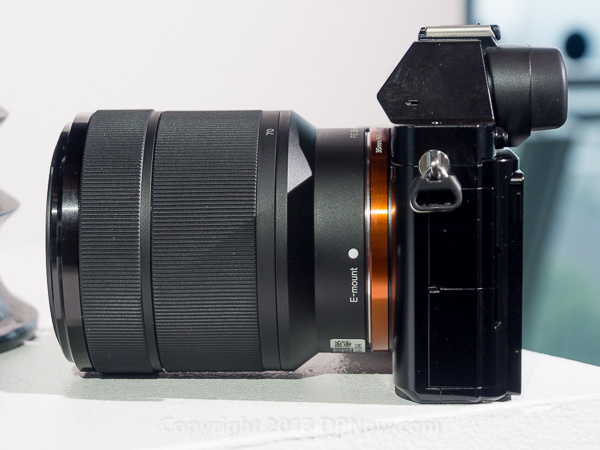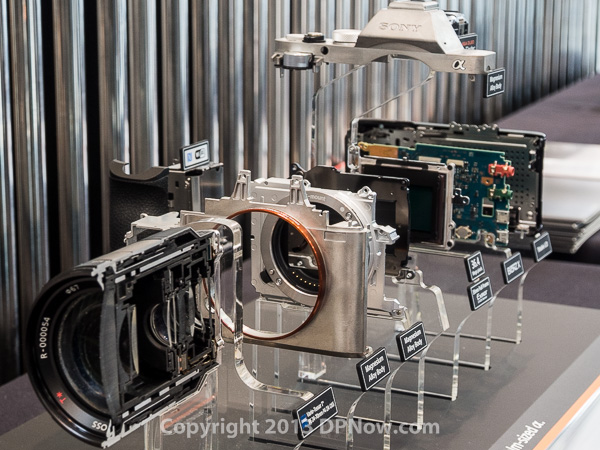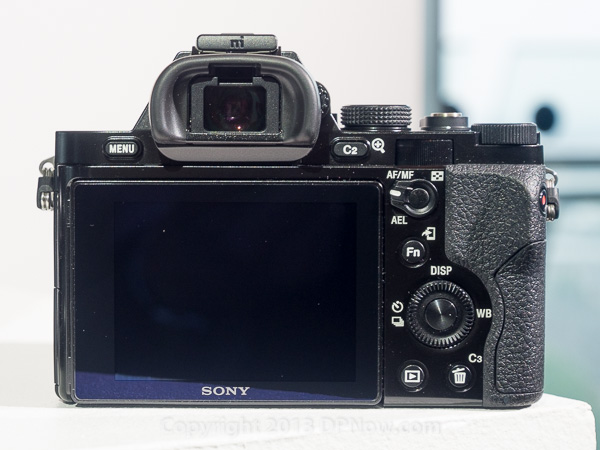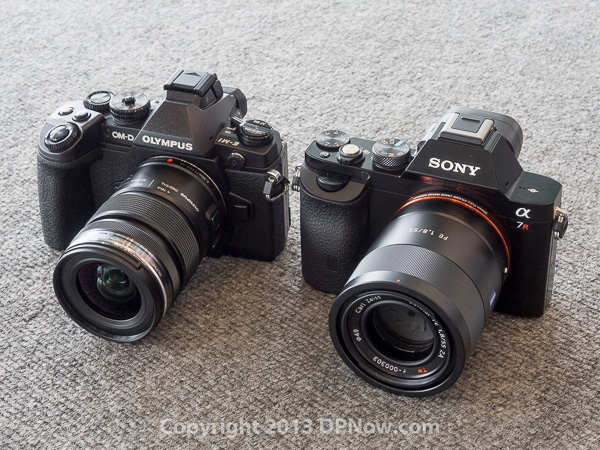Goodbye NEX, hello full frame FE-mount

The new full frame 36 megapixel Sony Alpha 7R fitted with optional battery grip and Carl Zeiss 35mm f/2.8 FE lens
Sony has revealed two new full frame mirrorless interchangeable lens system cameras based on what we have known until now as Sony's APS-C NEX system. The new 24 megapixel Alpha 7 and 36 megapixel Alpha 7R (R for resolution) use the same lens mount as Sony's NEX cameras but Sony has now admitted that it has abandoned the NEX brand. I certainly wondered why Sony introduced 'NEX' not long after Samsung had launched its 'NX' mirrorless system back in 2009. NEX lenses designed for the smaller APS-C sensor can be used with the new full frame Alpha 7 bodies and you are offered a choice of cropping to the smaller area covered by theses lenses.

An Alpha 7 fitted with its official kit zoom lens, the 28-70mm f/3.5-5.6 FE, which is not Carl Zeiss branded.
Sony says Alpha 7 doesn't mean the end of its A-mount DSLR-derived system and is promising a new A-mount body next year. The new Alpha 7 models are incredibly small and light considering they are full frame cameras and wifi connectivity with NFC capability are standard on both models. There is no GPS onboard, however, so you will have to rely on your phone or tablet for GPS data.

As we have seen with several E-Mount cameras from the NEX era the lenses can dwarf the camera body.
To get your head around Sony's news, which is rather complicated and confusing, you need to both forget about 'NEX' and base your understanding of Alpha 7 on... NEX. Sony endowed NEX with an extra wide lens mount and this makes it easier to implement a full frame version of a NEX body without excessive optical compromise. Alpha 7 bodies are basically NEX bodies with a full frame sensor. The NEX E-mount and flange/back distance are unchanged, but lenses for full frame bodies are referred to now as 'FE-mount' (F for Full frame) lenses. So how do you know which bodies are full frame and which are original APS-C? Apparently full frame bodies will use the '7' model number range. Sony's APS-C Alpha 3000 NEX model launched in August already had reduced NEX branding.

An exploded view of the Alpha 7
Alpha 7R
The Alpha 7R gets a 36 megapixel CMOS sensor and to process the huge amounts of image data Sony has developed a 3x faster Bionz X image processor. Even so, the maximum continuous shooting rate is limited to just four frames per second. Externally, the 7R is almost identical to the less expensive 24 megapixel Alpha 7. Both have environmentally-sealed magnesium alloy bodies and the same design layout and controls, plus the same XGA OLED electronic viewfinder and vertically tilting rear LCD screen. Unlike previous NEX models which favoured an electronic finder positioned at one end of a flat-topped body design, Sony has gone for a SLATER-style arrangement, placing the EVF in line with the lens. The differences between the two models are under the skin. The 7R not only has 50% more pixels but its sensor follows the recent trend of doing away with a low pass or anti-aliasing filter to maximise possible optical resolution.
Importantly, the 7R actually has a lower-specification autofocus system than its 24 megapixel sibling and must rely on contrast detection focusing only, although Sony says it has improved AF speed in the 7R over previous NEX models by 35%. Both models have focus-peaking capability for live-view highlighting of in-focus details.
Alpha 7
So the cheaper Alpha 7 has 'only' 24 megapixels but it has hybrid contrast-detection and phase-detection AF and it shoots at up to 5 frames per second. It also shares the same improved Bionz X image processor.

From the rear the Alpha 7 looks fairly straightforward. The screen tilts up and down and unusually, the single SD card slot accepts the card from the back rather than from the side of the camera.
With its phase-detection AF capability the 7 will work better with A-mount DSLR lenses than the 7R when using the cheaper and simpler LA-EA3 adapter for fitting A-mount lenses, but only if those lenses have integrated focus motors. The LA-EA3 does not support the old-style in-camera focus motor arrangement that focuses the lens through the lens mount using a drive-shaft. For that you will need the LA-EA4 adapter which also incorporates an SLT mirror and its own phase-detection focusing system.

The enormous 16-35mm f/2.8 Carl Zeiss AlphaDSLR lens fitted to an Alpha 7 via an LA-EA4 adapter
Initial observations
Based on a fairly short time handling both the 7 and 7R I have noted some good and not so good observations. Probably the most controversial aspect of these cameras is the styling. Personally, I'm not a fan of the rather stark and angular 'pentaprism' but this is a very personal point of view and I'm sure many will agree with me while others will love it. Both cameras feel good when held thanks to a well-designed hand-grip and the solidity of a magnesium alloy body. The positioning of the shutter release high on the top plate instead of forward on the grip caught me out a few times. I can't say too much about the control ergonomics without more time with the camera although I feel it's surprising that Sony didn't endow the camera with a touch screen. The new OLED viewfinder view is large and bright although I did occasionally notice some brief freezing of the view - but we were using pre-production cameras, so this may be a teething problem only. For some the prospect of only 4 or 5 frames per second continuous shooting could be an issue. Once again I am a little disappointed in the loud and unrefined sound Sony seems content to allow its cameras' shutters to make - especially considering there is no mirror in there the decibels are too high in my opinion.

Sony decided to go for optical image stabilisation with NEX cameras and so the E-mount based full frame Alpha 7 models have followed. I think this is a mistake. OIS is best for DSLRs - it has the advantage of stabilising the focus sensors as well as the image, an important advantage over sensor-shift DSLRs, like - indeed - Sony Alpha DSLRs and SLT models. In a mirrorless body a sensor shift system has no such disadvantage and holds the joker card in being able to stabilise any lens attached, even old manual focus lenses that don't electronically communicate with the camera body. Therefore, I don't see the Alpha 7s being popular for sports and low light photography without being attached to a tripod. Of course a tripod-mounted Alpha 7R is almost certainly going to be a landscape photographer's dream with the right lens and both look like they will be in their element in the studio environment.

I wonder if Sony had full frame plans for the E-mount right from the start of the NEX system, which would explain its extra-wide dimensions.

The Olympus OM-D E-M1 is actually one of the larger Micro Four Thirds camera models available and the Alpha 7, although small, looks slightly larger. But what really tells is the relative sizes of the lenses. The Alpha 7R here is fitted with a 55mm f/1.8 Carl Zeiss FE lens but the Micro Four Thirds equivalent (a Leica 25mm f/1.4) would be completely dwarfed by the FE lens despite being slower.
One should also not underestimate the attraction of of the compact and lightweight dimensions of the Alpha 7 series and this will undoubtedly attract travellers no longer willing to lug a huge back of heavy DSLRs. However, full frame cameras still need relatively big and heavy full frame lenses even though FE-mount lenses, especially wide angle ones, will be relatively small and light compared to their DSLR counterparts. But then again, standard E-mount lenses for APS-C camera body models will be smaller and lighter still and Micro Four Thirds even smaller and lighter again.
One thing Alpha 7 must deliver is absolute image quality. This is the primary raison-d'etre for full frame, especially now that smaller sensor cameras are already very good.
Sample images
We were kindly allowed to take shots using early pre-production cameras at the launch venue in London. There was limited time plus a lot of demand for cameras from journalists present so I was not really able to produce many decent sample images but here is a small selection. They cameras were so early that the exif data doesn't even identify the camera model (all were taken using the 24MP A7 because the A7R I tried proved to be faulty):
To view the photo in your browser just click on the appropriate thumbnail below. To download the image file, use the 'save target as' or equivalent function on your browser. All sample images provided here are copyrighted and made available for personal, non-commercial, evaluation only.
Reader feedback:
Discuss this story:




